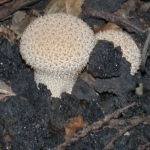| Common Name: |
Puffball |
| Botanical Name: |
Lycoperdon perlatum syn. L. gemmatum |
| Genus: |
Lycoperdon |
| Family: |
Lycoperdaceae |
| Cultivation: |
Well-drained, moist, sandy soil. |
| Propagation: |
By spores sown when ripe on a suitable substrate. |
| Harvest: |
Whole fungi are collected in summer and used fresh for food, or in autumn and dried for use as pills and powders. Spores are collected in autumn and dried for powder. |
| Native Location: |
Temperate regions worldwide |
| Height: |
2.5-9cm (1-3½in) |
| Width: |
2.5-6cm (1-2½in) |
| Hardiness: |
Z4-9 |
| Parts Used: |
Whole plant, spores (ma bo) |
| Properties: |
An astringent herb that controls bleeding. |
| Medicinal Uses: |
Externally for bleeding wounds and hemorrhoids. In traditional Chinese medicine, spores are given internally, combined with honey or syrup, for inflammations of the respiratory tract, and used externally, as a powder to stop bleeding. |
| Culinary Uses: |
The firm white flesh of young puffballs is eaten as a delicacy, often batter-fried. |
| Bibliography: |
Encyclopedia of Herbs by Deni Brown. Copyright © 1995, 2001 Dorling Kindersley Limited. pp 267-268
|

